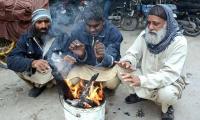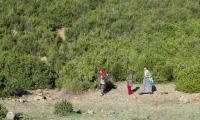It is obvious now how a newly rediscovered theory of hybrid and 4th generation warfare is helping evolve a hybrid democracy and media and civil society which can “combat hybrid threats” since the “synergetic application of the entire national potential and all elements of national power is the only way to be victorious in a hybrid war” (Lt Gen (r) Shafaat Ullah Shah). Is this an effective way to counter the multifaceted non-kinetic wars against Pakistan – or a recipe for totalitarianism?
The top leadership of Nato failed to agree on a single definition of the concept (hybrid warfare), according to Gen Shah, since “it is often used as a catch-all term for all non-linear threats”. But our worthy strategic military and civilian experts have succeeded in exactifying the term in a special issue of Hilal magazine. The confusion among our ‘defence analysts’ is rather obvious; Brig Ehsan Mehmood Khan, while talking about US, Russia, Israel and India, admits that “competing concepts, perspectives and terminologies are being used to explain the phenomenon of hybrid warfare”.
Referring to Brig (r) Anil Gupta of the Indian Army, who said that “Pakistan has been using hybrid threats against India since independence” and “a section of Indian (political and social) elite is also a tool of Pakistan’s hybrid warfare against India”, Brig Khan admits that “the Indian perspective is inversely shared by Pakistan” Indeed, alarmingly, according to Brig Khan, “India is contemplating three domains of new triad by establishing a Defence Cyber Agency, Defence Space Agency and Special Operation Division”. Therefore, he recommends that “this calls for integration of society in [the] state’s efforts” in countering and launching hybrid warfare ie militarisation of Pakistan.
Interestingly, Brig Gupta and my ex-colleague Amir Zia seem to be on the same page in identifying the enemy-within, rather than outside, who become instrumental in playing second fiddle to the enemy’s hybrid warfare. According to Zia, “fringe dissident elements – the shadowy nationalist militant groups to handful of social media activists, elements from academia, media and the NGOs – within Pakistan have been influenced to echo the enemy’s propaganda line’.
In his article, ‘Hybrid warfare manifested’, Zia’s emphasis is not against the principal threat of religious extremism and terrorism, which in most cases have become a tool of foreign powers in their hybrid warfare against Pakistan, it is essentially against Pakistan’s liberal intelligentsia, sections of civil society, critical voices in the media and academia and parties that are not ready to coalesce in to the hegemony of the power structure. Indeed, according to this ‘neo-McCarthyist prescription’, what we witness today is: an abortion of democratic resistance, degeneration of a decade-long democratic transition culminating into a client quasi-civilian regime, outlawing of the civil society and its replacement with fascist militias and extremist outfits, de-sizing of the media and exclusion of dissenting voices.
In trying to find some credence to this hybrid doctrine of recent times, recourse to the ‘Art of War’ by Sun Tzu from the Spring and Autumn period of Chinese history (770-476 BC) seems quite problematically inverse to what the great Chinese strategist had in fact envisioned. Whereas Western strategists and the Subcontinent’s military leaders follow Clausewitzian concepts of “centre of gravity”, “balance of forces”, and focus on assembling superior power at the “decisive point” to achieve victories in pure military combats, Sun Tzu concentrates on developing a superior political and psychological position that helps win a war without fighting it.
According to Sun Tzu: “ultimate excellence lies not in winning every battle, but in defeating the enemy without ever fighting. The highest form of warfare is to attack the enemy’s strategy itself”. If we apply another maxim of Sun Tzu to the 1971 war, General Arora followed the dictum: “the victorious army is victorious first – and seeks battle latter”; Gen Yahya Khan’s strategy looks closer to Tzu’s subsequent saying: “the defeated army does battle first – and seeks victory later”.
Sun Tzu and his followers Mao Zedong in China and Ho Chi Min and Vo Nguyen Giap in Vietnam had neither conceived nor applied the Art of War against their own people. The question is: what is the principal threat to the security, liberty and life of the peoples of Pakistan? If Sun Tzu and Mao Zedong are any guide, the strategist must attack the strategy of the potential threat (kinetic, non-kinetic) from whichever enemy while remaining flexible, rather than discriminating and repressing own people, crushing dissent and excluding voices from dispossessed regions.
Given the prevailing neo-colonial mindset in the Subcontinent, if an Indian opposes the barbaric repression conducted by his/her state, s/he is dubbed a ‘Pakistani agent’ and if a Pakistani expresses his/her concern over the same issue in Pakistan s/he is called an ‘Indian or Afghan agent’. Ongoing competing proxy wars are glossing over rights-based movements, leading to more suffering for the people.
Russian strategist Andrew Korybko, as quoted by Brig Khan, has noted that “Russia’s Eurasian integration objectives and China’s Silk Road projects are the targets of US global Hybrid Warfare strategy”. Calling Pakistan a “zipper” of Pan-Eurasian economic integration, Korybko says that Pakistan is also likely to be a target of hybrid warfare. Let there be no two views over CPEC and to build Pakistan’s own productive economic base and develop our human and physical infrastructures and self-sustenance. The attacks on the Chinese consulate and in Khyber Pakhtunkhwa require us to address both the internal and the external aspects of this situation.
We must find a political solution to the alienation of the Baloch youth. We must also keep out of the sectarian divide in the wider Middle Eastern region, proactively promote reconciliation in Afghanistan and continue with our peace offensive towards India with such disarming offers like the opening of the Kartarpur corridor and observance of ceasefire agreement across the LoC, as remarkably proposed by Gen Qammar Javed Bajwa.
The implosion of states essentially takes place from within due to social, economic, political, ethnic, ideological and systemic fault-lines. Explosion is exogenously driven and may exploit endogenous fissures to its advantage. We have taken immense losses while pursuing a flawed and over-stretched national security paradigm and we have had to pay an immense price for that in terms of the Talibanisation and militarisation of our state and society.
A holistic strategy is needed to address our various fault-lines, and the systemic imbalances, deprivations and repression of our own people. This policy must adhere to strengthening of a constitutional and democratic rule, upholding of civil and human rights, inclusion of real stakeholders and ethno-religious minorities, inclusive and sustainable growth and peace and cooperation in the region.
Any movement towards total authoritarianism will be lethal for the federation of Pakistan and will play into the hands of various hostile ‘hybrid wars’ rather than thwarting them. Only people from all the federating units can defeat all the nefarious designs against Pakistan.
The writer is a senior journalist.
Email: imtiaz.safma@gmail.com
Twitter: @ImtiazAlamSAFMA
There are over 11 million Pakistanis settled abroad, out of which around six million work in Gulf and Middle East
This year alone, US Treasury would have to roll-over $10 to $14 trillion in maturing short-term debt
Tear gas no longer marks just protest sites; it paints entire cities as battlegrounds but then again, PTI did it first
Political structures and governance systems have been central to economic and social development
It is confirmed now 40 Pakistanis had died after boat of migrants had capsized in sea near Greece
Many people believe that in future, AI will play an even more significant role in their lives







